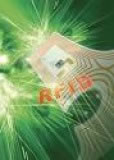| Home | Advantages & Best Practices | Successful Story | Useful Links |
 Radio-frequency-identification (RFID) is an automatic identification method, relying on storing and remotely retrieving data using devices called RFID tags or transponders. The technology requires some extent of cooperation of an RFID reader and an RFID tag. RFID tags come in three general varieties:- passive, active, or semi-passive (also known as battery-assisted or semi-active) and beacon types. Passive tags require no internal power source, thus being pure passive devices (they are only active when a reader is nearby to power them by wireless illumination), whereas semi-passive and active tags require a power source, usually a small battery. Beacon tags transmit autonomously with a certain blink pattern and do not respond to interrogation.
Radio-frequency-identification (RFID) is an automatic identification method, relying on storing and remotely retrieving data using devices called RFID tags or transponders. The technology requires some extent of cooperation of an RFID reader and an RFID tag. RFID tags come in three general varieties:- passive, active, or semi-passive (also known as battery-assisted or semi-active) and beacon types. Passive tags require no internal power source, thus being pure passive devices (they are only active when a reader is nearby to power them by wireless illumination), whereas semi-passive and active tags require a power source, usually a small battery. Beacon tags transmit autonomously with a certain blink pattern and do not respond to interrogation.
RFID is not a new technique. In 1948, Harry Stockman published a paper entitled “Communication by means of reflected power” that discussed the theory and implementation of RFID (Stockman, 1948). Vernon and Harris published papers entitled “Application of the microwave homodyne” and “Radio transmission systems with modulatable passive responder”, respectively (Vernon, 1952; Harris, 1960). After that, the development of RFID continued. From 1980 to 1990, RFID systems gradually matured, including use by, for example, the Association of American Railroads and the Container Handling Cooperative Program. RFID initiatives simplified the identification and tracing procedures in the process of merchandise delivery. As a result the application of RFID soared (Landt, 2001).